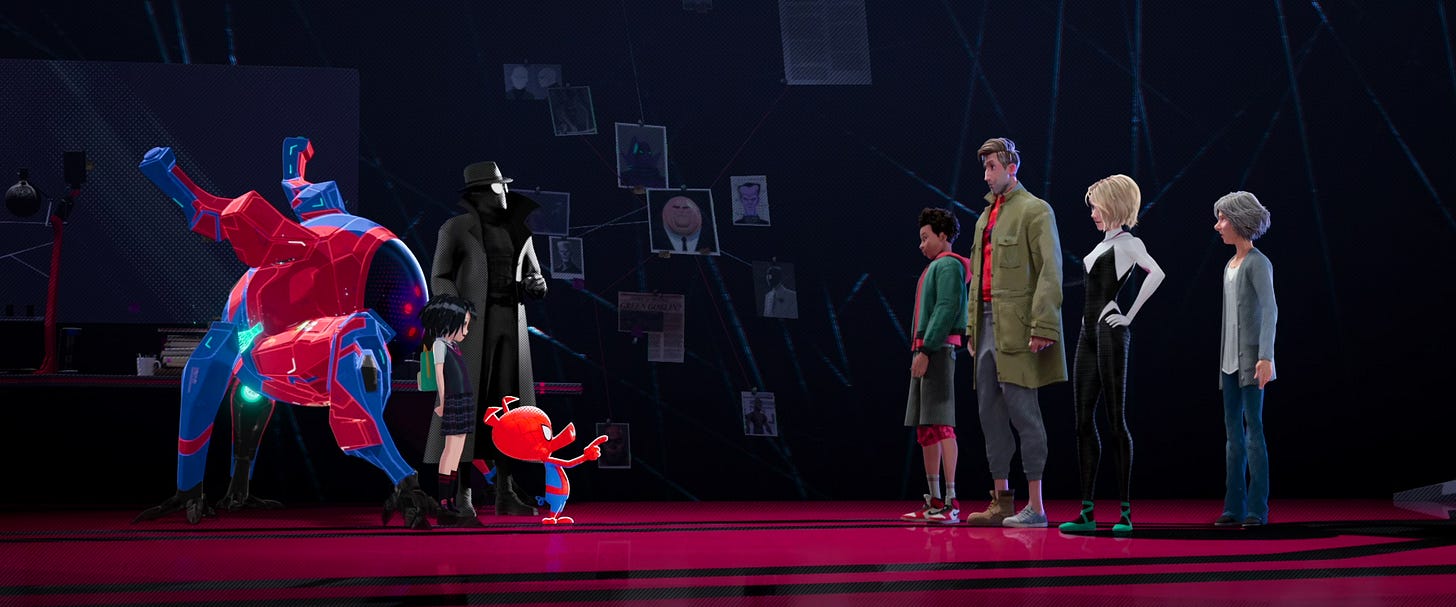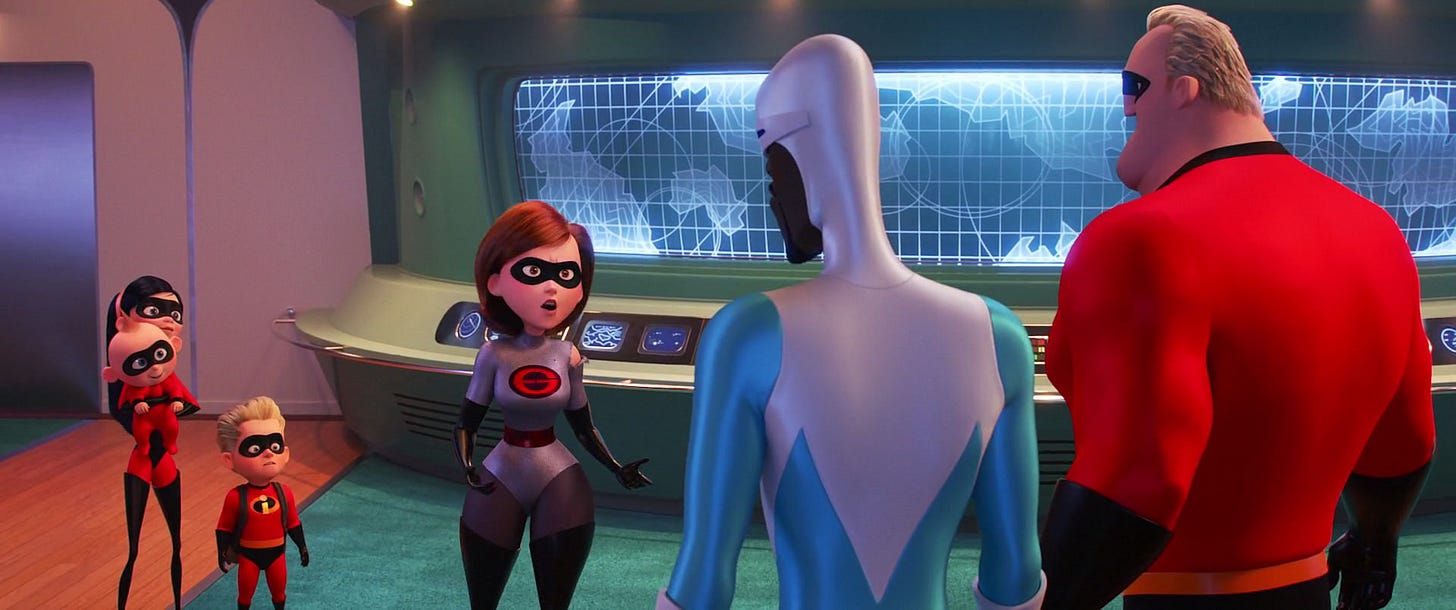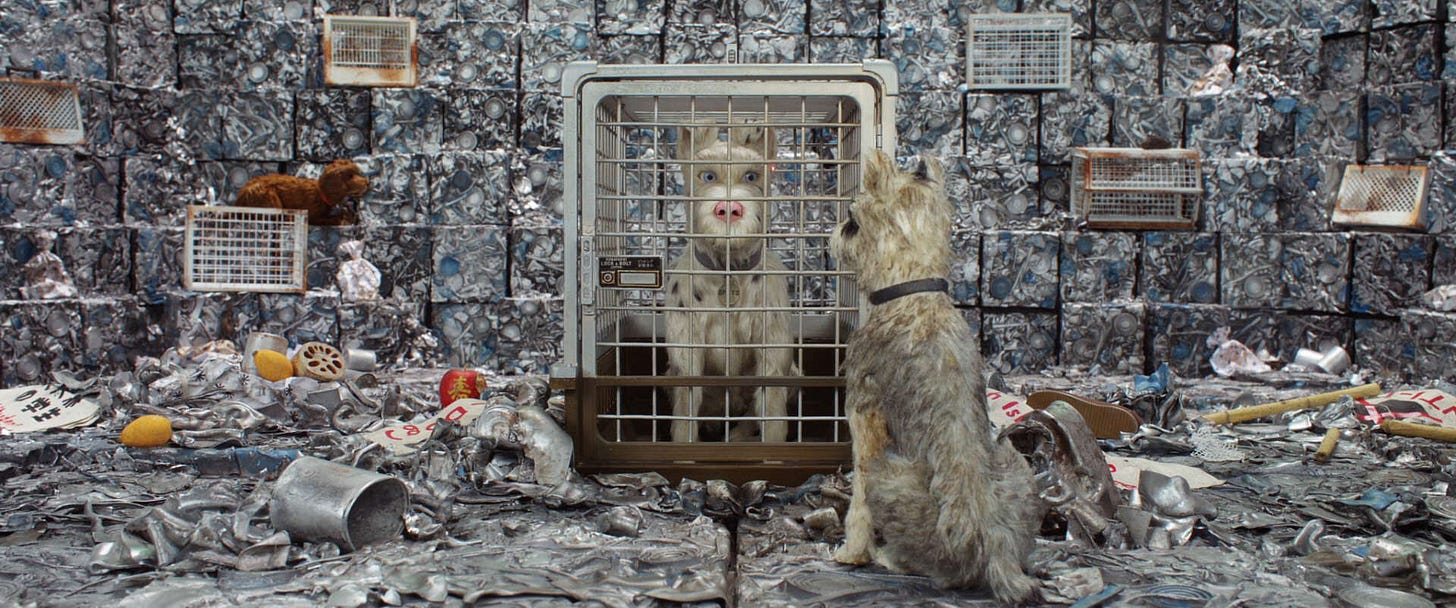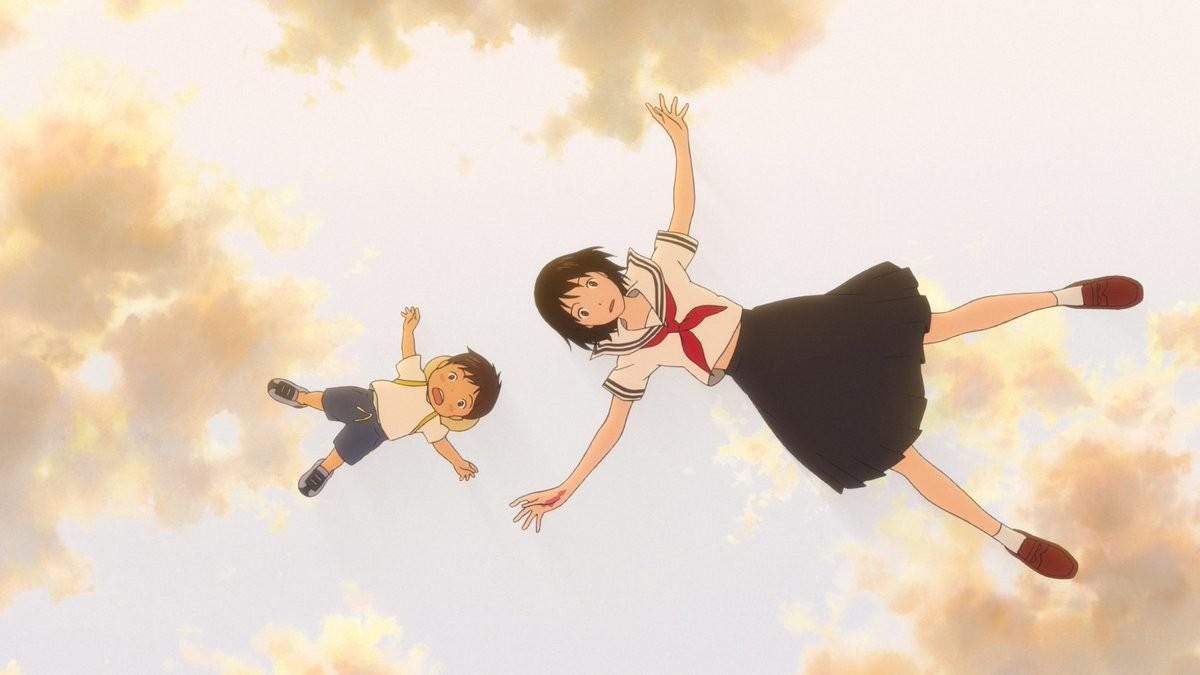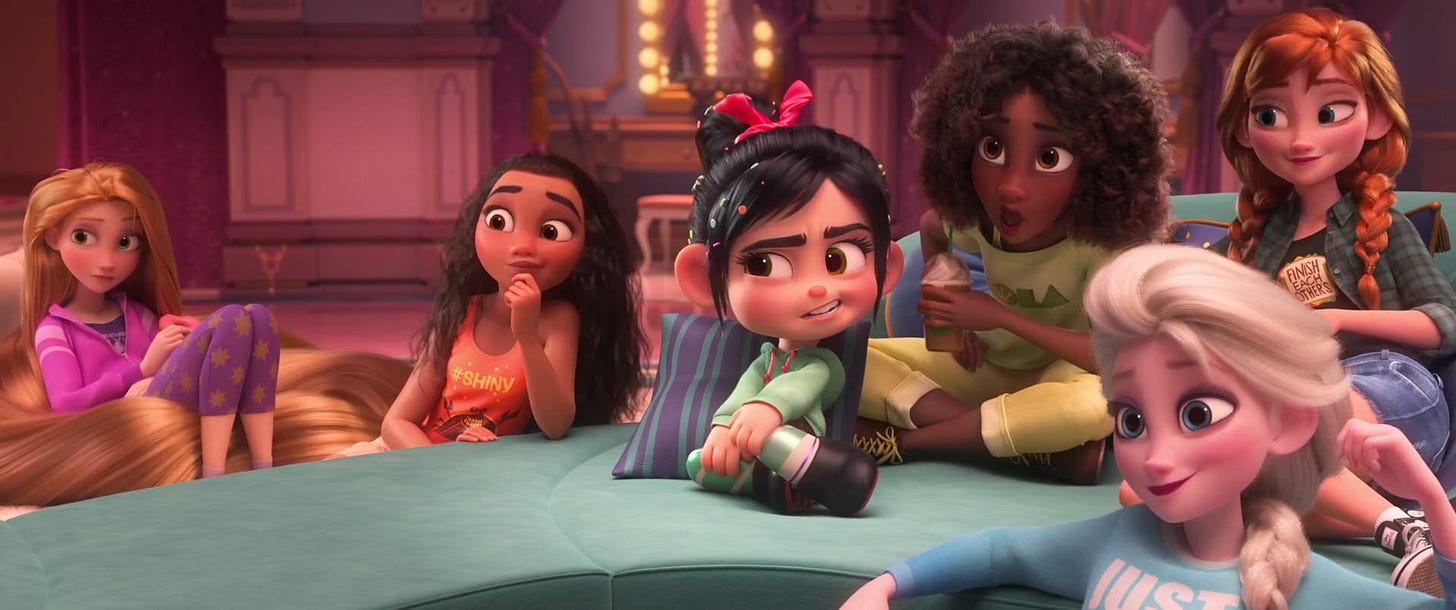Better Animated Feature: 2018
It's Miles Morales' multiverse and we're all just living in it.
This post may be too long for email. We recommend clicking through to the website for the best experience.
Eli: In one corner, we’ve got two of the most disappointing sequels in the history of animation and two relatively unknown indie films.
In the other corner is an all-time classic widely regarded as one of the very best animated films ever released.
Round 1: begin!
The Nominees
Spider-Man: Into the Spider-Verse (won Best Animated Feature)
Incredibles 2 (nominated)
Isle of Dogs (nominated)
Mirai (nominated)
Ralph Breaks the Internet (nominated)
The “Best” Animated Feature: Spider-Man: Into the Spider-Verse
David: Few movies so immediately stand out in their field the way this one has.
Into the Spider-Verse knows the character of Spider-Man innately, and with this information, decides to write an absolute love letter not only to the character, but to superheroes—and does it while being some of the most fun you could have gotten out of an animated movie up until the release of its sequel, Across the Spider-Verse, in 2023. More on that in a few months.
Superhero movies have long suffered from a case of “taking themselves too seriously”. There’s a reason for that, sure—most movies aren’t dealing with a war against the sort of force that could snap half of life out of existence entirely, but a lot of these films have devolved into the sort of cynicism that pulls at the worst parts of my soul. Storylines feel tagged to the specific whims of what will grant the largest profit, and when they aren’t, they’re tailored to an obsessive, often-moody fanbase.
Countering that is Spider-Verse, a blinding flash of color and joy that gives the animation genre a blinding kick in the butt the way The Lego Movie should have a few years ago—and it works.
Sure, you play to the typical Spider-Man themes of coming into one’s powers all while dealing with the whims of adolescence—hard enough when you’re not experiencing the aftereffects of a radioactive spider bite—but it never lingers too long, choosing instead to spiral into myriad fantasies of color and light and emotion. Moments of deep sincerity are allowed their time in the sun without letting them overshadow the humor, nor does that same humor follow the oft-panned comedy style that has become a bit too common in Marvel’s latest.
The animation is beyond anything I’ve ever seen; it’s a full-on assault on the senses, but one that is pin-point accurate, using the stylized lines to indicate spider-senses, splashes of neon and otherworldly hues to bring forth new characters and new emotions, painting the city and the world in a light we would only be so lucky to see it in.
As Eli touches on a little ways down, my greatest gripe is that less time is spent on Miles in this film than I want, but that is such a minor issue on the whole, and I can’t truly see how any other movie on this year’s board (and truly, few movies in the whole project) can attune to this whirlwind masterpiece. A genuinely deserving film.
The Other Animated Features
Incredibles 2 — Eli
Nominated
We finally got it: the Pixar sequel everyone had been asking for since the Bush administration. And, well, it’s not good. You know it. I know it. Brad Bird probably knows it. Everybody wanted a new Incredibles classic and instead we got…sigh.
Incredibles 2 has rightly been derided for retreading story beats from the first movie in a less interesting fashion, for the character assassination of Mr. Incredible, and especially for following up an all-time great antagonist with one of the most poorly written villains in the history of animation. Terabytes of digital ink have been spilled comparing this nonsense to the far superior film it follows; it’s just not a very interesting angle.
Luckily, this project offers something different. This year’s winner, Into the Spider-Verse, is a much better modern animated superhero movie, groundbreaking in all the ways The Incredibles was back in 2004 and more. It gives us an answer sheet of sorts—an example of what Incredibles 2 could have been with a little more effort.
Okay, a lot more effort.
For this exercise, let's try to forget about all of the things that make Incredibles 2 a bad sequel and just compare it to Into the Spider-Verse on its own merit as a superhero movie.
We can start with the superheroes themselves. Both movies feature one superhero trying to help another become more comfortable using their powers. That dynamic between Peter B. Parker and Miles Morales is the driving force behind Into the Spider-Verse, and it’s played perfectly from beginning to end. Peter wants so badly for Miles to succeed and goes to great lengths to defend him while the other Spiders insist he’s just holding them back. It pains Peter so much to admit that they’re right, but when he finally does, Miles does some true soul searching, finally takes hold of his powers, and saves the world.
Meanwhile, in Incredibles 2, Helen is originally apprehensive about using her powers in public, but Bob talks her into it—largely for self-interested reasons, but also for the fate of all superheroes. Then Helen immediately succeeds because she’s a seasoned veteran, and Bob can hardly hide his envy and turns into a huge jerk about it. What a happy marriage! This tension is never sufficiently resolved, by the way.
Each movie also features a supporting cast of sidekick superheroes that mainly serves as comic relief. In Spider-Verse, it’s the Spiders: Spider-Man Noir, Spider-Ham, and Peni Parker. Admittedly, the movie focused on them a bit too much for my liking, but you can’t deny how well they were done. Each has not only a unique personality, but also a distinct art style that surrounds them wherever they go throughout the film. It’s a big part of what makes Spider-Verse such a marvel (no pun intended).
Incredibles 2, on the other hand, has the ragtag group of supers Winston brings out of hiding while Helen is doing her thing: Voyd, Krushauer, He-Lectrix, Blazestone, Reflux, Screech, and Brick. Pretty much all of these people are interchangeable. Voyd is the only one they even try to give a personality, two of them (Krushauer and He-Lectrix) have the same voice actor, two of them (Screech and Brick) don’t even have a credited voice actor despite having speaking lines, and one (Blazestone) is actually not in this movie and is instead one of the supers the Omnidroid killed in the first movie. You didn’t even notice. A common compliment reviewers have for Incredibles 2 is that the animation is great (especially compared to the first movie), and while Pixar did put in their usual outstanding work into making everything look exciting and flow smoothly, I can’t help but think they could have done more to distinguish not just these secondary heroes, but even the main cast.
I could yap for a couple paragraphs on how much better of a villain Kingpin is than The Screenslaver, but this review is already running pretty long, so I’ll just reiterate that the Kingpin did not actively help the heroes foil his own plan for more than half of the movie. Villainy 101 stuff right here guys, come on.
Incredibles 2 isn’t just a bad sequel to The Incredibles; it’s a bad superhero movie to its core. Not only did it not come close to deserving this award, but it’s also the first nominated Pixar film I would argue didn’t even deserve its nomination.
Verdict: Not a better animated feature
Isle of Dogs — Leah
Nominated
Talking dogs may be a staple in animation, but Isle of Dogs offers a unique take on the concept. Canine flu is spreading throughout Japan, giving dog-hating Mayor Kobayashi of Megasaki an excuse to banish all dogs to Trash Island. His political opponent for the mayoral office is working on a cure, but that’s not enough to stop Kobayashi. We’re introduced to a pack of alphas named Rex, Duke, Boss, King, and Chief (the pack’s leader). While struggling to survive on Trash Island, they find a boy has crash landed a plane and is in search of his missing dog, Spots. They vote to help the “little master” and search for Spots, going on a journey through the island.
Isle of Dogs is animated with stop-motion. Wes Anderson brings his unique directing style to the film, making it stand out from other stop-motion films that have been nominated in the past. The character designs are charming and the artists did a great job creating the cast of canine characters. The film leans more realistic than cartoony, but doesn’t veer so far into realism that the movie’s style is uncanny or boring. For instance, the movie borrows the cartoon trope of a large fight being represented by a cloud with a bunch of action and movement within it—a unique visual that pays homage to classic animation. The visuals are definitely one of this movie’s strengths, and they can be quite striking, enhancing the experience of the film.
The story and themes of the movie are engrossing, and the relationships between both the canine and human characters are well developed. The story also does a good job of showing political corruption and how political authority can be wielded to a harmful end (exiling all the dogs to Trash Island and attempting to eliminate them). I only wish more politicians could be convinced to change their ways by a heartfelt speech from their young relatives. Chief going from a stray that distrusts humans to caring about the little pilot is a touching character arc.
So Isle of Dogs is a good film, and I’d recommend it to animation fans looking for a movie that’s more adult and unlike most of what’s out there for animation. However, it was nominated in the same year as Into the Spider-Verse, and the thing about Into the Spider-Verse is that it’s a medium/genre defining film that has a very strong case being the most influential film of the decade. It adapted the comic book style into an animated film in a way that had never been done before. It created an art style the likes of which had never been seen in animation before. Not only that, but it also had an amazing story and amazing music to complement the amazing visuals and create a wholly enjoyable cinematic experience.
This is the second year in a row I’ve had to say this, but it’s true again: in a weaker year, I absolutely would make a case for Isle of Dogs and all of its merits, but I can’t argue that it’s more deserving than what I believe is not only the most deserving film of the decade, but also the most deserving film in the entire history of the award. So, for as much praise as I have for Isle of Dogs, I have to judge it:
Verdict: Not a better animated feature
Mirai — Preston
Nominated
Just under four months ago, and eight years ago in the chronology of Best Animated Feature awards, I covered Mamoru Hosoda’s Summer Wars in our piece for 2010. It’s a delightful mess of a movie—one that really shouldn’t work nearly as well as it does, with how much it’s trying to cram into a 114-minute runtime that should feel frenetic from beginning to end. The spectacular ambition of Hosoda’s work is quite clearly evident, and while it’s a shortcoming on some levels, it’s hard to deny that the final product is still a pretty remarkably great movie.
It’s also a near-unknown in the West, which has been perhaps the most prominent theme of Hosoda’s career—outside the near-unquestioned excellence of his filmography, of course. The opportunity for anime films to gain a serious foothold in the United States is limited, and arguably only Studio Ghibli has really achieved it with any consistency, but I think there’s a world where Hosoda could have become (and could still become) prominent on a greater level. An Academy Award would go a long way towards making that the case, as it would for almost any studio or animator…but Hosoda’s been somewhat unlucky in that not even a narrow window of opportunity for him to win one has ever really presented itself. Summer Wars was an afterthought in a year where the Academy only had three nominations to give out and Toy Story 3, How to Train Your Dragon, and Tangled all on the ballot. 2015’s The Boy and the Beast ran into the runaway train that was Inside Out, and 2021’s Belle—Hosoda’s most popular film thus far—was never going to win going up against Encanto.1
Mirai, released in 2018 amid a relatively weak year for animation (Incredibles 2 and Ralph Breaks the Internet are both in here, after all), had the best chance of any of Hosoda’s BAF submissions to win it, and it’s his only nomination in the category thus far. The weaknesses evident in Summer Wars, such as they are, have been mostly ironed out by this point; Mirai is a simpler concept, a story about a young boy longing for attention after his little sister’s birth, finding it by traveling through time to meet other members of his family.2 And the execution feels more serious, more confident that the story being told is a good one, with moments of humor that work with more consistency than we saw earlier in Hosoda’s career.
It’s a beautiful film, it really is…admittedly with pacing that feels a bit all over the place, perhaps inevitable given the underlying concept, but with undeniable heart and some lovely character work. When all was said and done, while it didn’t win Best Animated Feature, it did become the first non-Ghibli anime film to earn a nomination—and that’s a significant step not just for Hosoda, one of the most underrated filmmakers of the current generation, but also for Japanese animation as a whole as it aims to earn respect beyond the long shadow cast by Hayao Miyazaki.
But, of course, Hosoda’s luck is such that Mirai didn’t get to face off with one of the numerous BAF winners it could have pretty realistically beaten. Provided the Academy voters actually paid attention (rarely a given, to be fair), I think this film would’ve pretty seriously contended against anything from 2006’s Happy Feet to 2012’s Brave to, the year immediately after this, 2019’s Toy Story 4. But because it released in 2018, Mirai could only ever be a very impressive runner-up to one of the best animated films of all time—a movie that redefined not just the expectations for one corner of the genre, but reshaped the field from top to bottom for years to come. When Spider-Man: Into the Spider-Verse is your competition, second is hardly a bad place to be.
Verdict: Not a better animated feature
Ralph Breaks the Internet — Eli
Nominated
I’m gonna level with y’all: I’m a busy guy. I have a full-time job. I’m getting married next year. I have other hobbies and interests.
Sometimes I just don’t have it in me to write a detailed takedown of a movie that isn’t even trying.
Ralph Breaks the Internet exists because the creative team at Walt Disney Animation Studios bet their peers at Sony Pictures Animation that they could make a movie with a higher volume of nonsensical product placement than The Emoji Movie. It takes Disney’s best movie of the new millennium and replaces everything thoughtful and poignant with immediately dated memes and floating corporate logos.
In the first movie, Ralph truly cares about Vanellope and is fooled into sabotaging her dreams in an attempt to do something he thinks will save her life. In this one, Ralph is just an abusive, overprotective asshole. In the first movie, game jumping (or “going Turbo”) is explicitly frowned upon; it’s, like, the thing you’re not supposed to do. In this one, Vanellope spends the whole movie trying to go Turbo but it’s okay because she’s the protagonist.
There’s a Colleen Ballinger cameo in this movie. Remember her? Ralph accidentally interrupts the internet connection and a character modeled after her appears on-screen distraught for about a half-second. I would have rather had her stay and sing “Toxic Gossip Train” 12 times in a row than listen to Sarah Silverman squawk her way through “A Place Called Slaughter Race” once.
At least Sony recovered after The Emoji Movie. They went from that disaster to this year’s well deserved winner, Into the Spider-Verse, in 17 months. Disney wishes they could even sniff those heights these days. The closest they’ve come is Encanto, which won Best Animated Feature in 2021 because a Lin-Manuel Miranda song got stuck in everybody’s heads.3 Otherwise, it’s disappointments everywhere. All of their animation looks the goddamn same and they’re barely even writing good music anymore. Their next three upcoming films are all sequels.
The internet wasn’t the only thing Ralph broke in this movie. Disney is creatively bankrupt.
Verdict: Not a better animated feature
Running Tally
2001: 2 better (2 nominated; 3 snubbed)
2002: 1 better (4 nominated; 0 snubbed)
2003: 1 better (2 nominated; 2 snubbed)
2004: 0 better (2 nominated; 1 snubbed)
2005: 2 better (2 nominated; 2 snubbed)
2006: 3 better (2 nominated; 2 snubbed)
2007: 3 better (2 nominated; 1 snubbed)
2008: 0 better (2 nominated; 0 snubbed)
2009: 2 better (4 nominated; 2 snubbed)
2010: 3 better (2 nominated; 4 snubbed)
2011: 1 better (4 nominated; 0 snubbed)
2012: 4 better (4 nominated; 1 snubbed)
2013: 2 better (4 nominated; 0 snubbed)
2014: 3 better (4 nominated; 1 snubbed)
2015: 2 better (4 nominated; 0 snubbed)
2016: 5 better (4 nominated; 1 snubbed)
2017: 0 better (4 nominated; 0 snubbed)
2018: 0 better (4 nominated; 0 snubbed)
TOTAL: 34 better (56 nominated; 20 snubbed)
Wow, two consecutive years we all agree the Academy got right! Maybe they’re finally taking animation seriousl—hahahahaha. Lmao!
Sorry. Couldn’t finish that sentence without laughing.
Anyway, here’s Toy Story 4…
Next: 2019 (4 nominated; 0 snubbed)
Editor’s note: Jeez, spoilers! —Eli
Yes, I said simpler. Summer Wars is just like that.
Ah jeez, I guess the real spoiler is me. I also feel compelled to add that I like Encanto and this wasn’t meant as a dig.







